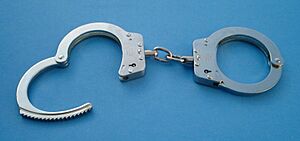Handcuffs facts for kids
Handcuffs are a type of restraint often used by police. They help make sure that people who are arrested cannot escape or hurt anyone. Handcuffs work by securing a person's wrists together. They are usually made of metal and have two parts linked by a chain. Handcuffs cannot be removed without a special key. A person wearing handcuffs can only move their wrists a short distance apart.
Contents
Types of Handcuffs
There are three main types of handcuffs: chain, hinged, and solid bar.
- Chain handcuffs are the most common type. They have two cuffs connected by a short chain.
- Hinged handcuffs have two cuffs connected by a hinge. This makes them less flexible than chain cuffs.
- Solid bar handcuffs are even more rigid. They are harder to carry but offer different ways to secure someone.
Both rigid and hinged cuffs can help officers control someone safely using just one hand.
In 1933, the Royal Canadian Mounted Police used "Mitten Handcuffs." These were designed to stop criminals from grabbing an officer's tools, like their gun. Some law enforcement groups used them, but they never became very popular.
Handcuffs can be made from different metals, such as carbon steel, stainless steel, and aluminium. Some are also made from strong polymer plastics.
The National Museum of Australia has a collection of old handcuffs. Some of these date back to the late 1800s and early 1900s.
Double Locks
Many handcuffs have a "double lock" feature. This is a special part that stops the cuff from getting tighter after it's locked. This is important because handcuffs can cause nerve damage or stop blood flow if they are too tight.
Some people might try to tighten the cuffs on purpose to escape when an officer tries to loosen them. Double locks prevent this. They also make it much harder for someone to pick the locks.
There are three main ways double locks work:
Lever Lock
With a lever lock, you move a small lever on the cuff. This locks the bolt in place. You don't need any special tool to set this type of double lock.
Push Pin Lock
For a push pin lock, you use a small peg found on the handcuff key. You insert this peg into a small hole on the cuff to engage the lock.
Slot Lock
Similar to the push pin, a slot lock also uses a peg. However, you insert the peg into a slot and then slide it sideways to lock the cuff.
Plastic Handcuffs
Plastic handcuffs are lightweight strips that look like large electrical cable ties. Police officers and soldiers can carry many of them easily. They are very useful in situations where many people need to be restrained, like during big protests or riots.
Recently, airlines have started carrying plastic handcuffs. They use them to restrain passengers who cause trouble during flights.
One downside is that disposable plastic handcuffs cannot be loosened. They have to be cut off if a person needs to be fingerprinted or use the bathroom. This can make them seem expensive if used often.
However, they are cheap to buy and are used in situations where metal handcuffs might not be available. Newer plastic restraints exist that can be opened with a key. These are more expensive and not as strong as metal ones. Many people also believe plastic restraints are more likely to cause nerve or soft-tissue damage than metal handcuffs.
Legcuffs
Sometimes, if a person is very aggressive, leg irons (also called legcuffs) are used. These secure a person's ankles together. Sometimes, the chain connecting the legcuffs is linked to the chain of the handcuffs.
In rare cases, people lying on their stomachs while restrained have had trouble breathing. Because of this, using legcuffs in certain ways is now restricted or even banned in many places.
Handcuff Keys
Most handcuffs used today in Canada, the United States, the United Kingdom, and Latin America can be opened with the same standard key. This makes it easier to transport people who are arrested. However, some handcuff makers use different keys. Special keys are needed for maximum security handcuffs.
Handcuff keys usually do not work with thumbcuffs, which are smaller restraints for thumbs. The Cuff Lock handcuff key padlock also uses this standard key.
Besides the common handcuff key, some modified designs exist. For example, one type of key is made to fit behind an officer's badge.
Images for kids
-
Standard type legcuffs made in Taiwan.
-
A display of old handcuffs at Tatton Park Flower Show, 2010.
See also
In Spanish: Esposas para niños











